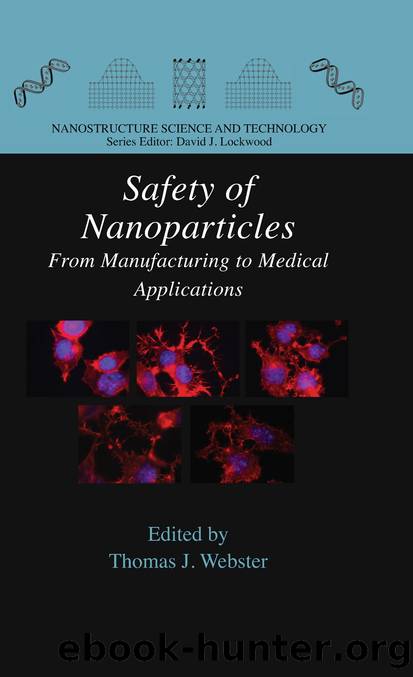Safety of Nanoparticles by Thomas J. Webster

Author:Thomas J. Webster
Language: eng
Format: epub
Publisher: Springer New York, New York, NY
6.4 Accelerated Blood Clearance (ABC) of PEGylated Liposomes upon Repeated Injections
6.4.1 ABC Phenomenon
In the absence of encapsulated or surface coupled proteins, PEGylated liposomes are generally considered to be non-immunogenic (van Rooijen and van Nieuwmegen 1980; Alving 1992; Harding et al. 1997). However, it recently has been demonstrated that upon repeated injections, the circulation time of PEGylated liposomes dramatically decreases while their uptake by the liver increases concomitantly (Dams et al. 2000a; Ishida et al. 2003a, b). This so-called ABC phenomenon was observed in rats, mice, and a Rhesus monkey (Dams et al. 2000a; Laverman et al. 2001; Ishida et al. 2003a, b). It was demonstrated that the extent of the ABC phenomenon, induced following prior injection of PEGylated liposomes, depends on the time interval between the first and second injections (Fig. 6.2) (Ishida et al. 2003b, 2006c). When the second dose was given at Day 3, post-first injection, the elimination rate nearly doubled compared to the control. At 4â7 days post-first injection, a further increase in blood clearance was observed. Beyond 8 days after the first injection, the elimination rate dramatically decreased, but significantly ABC was still observed even at 14 days post-first injection (Fig. 6.2A). The accumulation of the second-dose PEGylated liposomes in the liver gradually increased in relation to the time elapsed after the first injection, reaching a maximum level (7- to 8-fold larger than the control) at 4â6 days post-first injection, and gradually decreasing after Day 10 post-first injection. However, even at Day 14, significantly enhanced liver accumulations (5-fold larger than control) were still observed. Significant accumulations of the PEGylated liposomes were observed in the spleen at Days 3 and 4 post-first injection, although at substantially lower levels than in the liver and hardly different from the control values (Fig. 6.2B). The intrahepatic distribution of the PEGylated liposome was studied with a transmission electron microscopy (TEM). A single injection of PEGylated liposomes showed low accumulations in the liver 2 h after injection (Fig. 6.3A), in accordance with established long-circulating properties of such liposomes. After induction of the ABC phenomenon, however, rapid massive internalization of PEGylated liposomes by the macrophages of the liver (Kupffer cells) was observed at 2 h post-injection (Fig. 6.3B and C). These findings clearly indicate that, under conditions in which the ABC phenomenon is induced, PEGylated liposomes can still react with the biological milieu, despite their established steric stabilization with PEG.
Fig. 6.2Accelerated blood clearance and enhanced organ uptake of a second dose of PEGylated liposomes. Rats were pretreated with PEGylated liposomes (lipid dose, 0.001 μmol/kg). (A) Blood clearance of a second dose of radio-labeled PEGylated liposomes (5 μmol/kg). (B) Hepatic and splenic accumulation at 24 h following the injection. Each value represents the mean ± SD (n=3). p values apply to differences between the control and treated rats. * p< 0.05, *** p< 0.005, Cited from Ishida et al. (2005) with permission from Elsevier
Download
This site does not store any files on its server. We only index and link to content provided by other sites. Please contact the content providers to delete copyright contents if any and email us, we'll remove relevant links or contents immediately.
| Automotive | Engineering |
| Transportation |
Whiskies Galore by Ian Buxton(41529)
Introduction to Aircraft Design (Cambridge Aerospace Series) by John P. Fielding(32888)
Small Unmanned Fixed-wing Aircraft Design by Andrew J. Keane Andras Sobester James P. Scanlan & András Sóbester & James P. Scanlan(32573)
Craft Beer for the Homebrewer by Michael Agnew(17932)
Turbulence by E. J. Noyes(7700)
The Complete Stick Figure Physics Tutorials by Allen Sarah(7137)
Kaplan MCAT General Chemistry Review by Kaplan(6595)
The Thirst by Nesbo Jo(6435)
Bad Blood by John Carreyrou(6274)
Modelling of Convective Heat and Mass Transfer in Rotating Flows by Igor V. Shevchuk(6222)
Learning SQL by Alan Beaulieu(6035)
Weapons of Math Destruction by Cathy O'Neil(5827)
Man-made Catastrophes and Risk Information Concealment by Dmitry Chernov & Didier Sornette(5645)
Digital Minimalism by Cal Newport;(5389)
Life 3.0: Being Human in the Age of Artificial Intelligence by Tegmark Max(5184)
iGen by Jean M. Twenge(5161)
Secrets of Antigravity Propulsion: Tesla, UFOs, and Classified Aerospace Technology by Ph.D. Paul A. Laviolette(4989)
Design of Trajectory Optimization Approach for Space Maneuver Vehicle Skip Entry Problems by Runqi Chai & Al Savvaris & Antonios Tsourdos & Senchun Chai(4839)
Electronic Devices & Circuits by Jacob Millman & Christos C. Halkias(4746)
